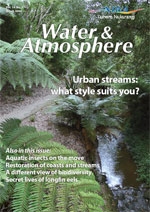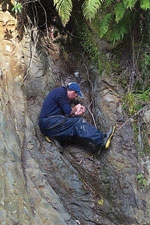PDF of this article (145 KB)



Water & Atmosphere readers have enjoyed Brian Smith’s close-up photos of aquatic insects for years. Whether he’s clinging to a rockface to sample a freshwater seep, or peering into a dissecting microscope, Brian has focused on caddisflies, mayflies, stoneflies, and their ilk since joining NIWA in 1993. In addition to collecting, dissecting, and describing bugs, Brian teaches some of NIWA’s training courses.
W&A – What is it about you and bugs?
Brian - I've been interested in insects since I was a little kid, so it was no surprise when I did entomology (the study of insects) at Canterbury University. The last two years of uni, I also focused on limnology (the study of lakes, streams, and ponds), which gave me my first interest in freshwater insects.
I like the idea of finding new or rare species of insects, so I guess that’s where my interest in taxonomy comes in. Taxonomy is the science of identifying, classifying, and naming organisms.
W&A – What’s the point of studying aquatic insects?
Brian - One reason we study them at NIWA is that they play an important role in biomonitoring. We can gauge the health of a stream or waterway by the insects that are there – or that aren't there. The streams in New Zealand bush are naturally cool and shady. These streams have high biodiversity, with lots of different types of aquatic insects. As the health of a waterway declines, we find less biodiversity. The invertebrates we find then in any abundance are more likely to be snails, worms, and other species that are more tolerant of pollution.
Most stream biomonitoring looks at juvenile insects in the water. What’s different about my work is that I focus on the winged adult stages, trying to figure out what happens when they leave the water. It was this interest that brought me to Hamilton in 1994 to work on a project that needed someone to identify the adult stages of aquatic insects. A lot of my work deals with land-use effects, longevity, diet, temperature tolerance, and dispersal. Some of these topics are included in my article in this issue.
W&A – What’s your best bug?
Brian - My greatest interest is the caddisfly or Trichoptera. Caddisflies are related to moths and butterflies, except the adults have hairs instead of scales on their wings. (Trichoptera means hairy wings.) Their larvae are like the caterpillars of the stream bed. I have a keen interest in all caddisflies, but have a particular fondness for the family Hydrobiosidae.
W&A – You've collected insects in some pretty special parts of New Zealand. What are some of your favourites?
Brian - Two of my most memorable collecting trips were to Fiordland, as part of a joint Smithsonian/Canterbury Museum project, and to Great Barrier Island (looking for caddisflies, naturally). The most productive environments in terms of rare or unusual species are seepages – that’s where groundwater comes out through the soil – and small, forested streams.
W&A – And you've also worked with collections overseas?
Brian - Through NIWA’s technical training grants, I've twice gone ovrseas to improve my taxonomy skills. In 1996, I spent five weeks at the University of Minnesota, working with South American caddisflies and also learning biological illustration. Then, in 2005, I went back to the States to work for a couple of weeks at Clemson University and for two weeks at the Smithsonian National Museum of Natural History in Washington. On that trip I was mainly working on a phylogenetic study to figure out whether a New Zealand caddisfly had been classified in the wrong family. [See 'Classifying caddis'.]
W&A – What’s the best part of the job?
Brian - Being out in the field is interesting (especially when the weather’s nice), but it’s also great to get back into the lab to see what you've collected. Typical work in the lab includes sorting through the samples and then identifying the insects using a dissecting microscope.
About five years ago we bought a Nikon Coolpix 995 digital camera that can be attached to the microscope. It seemed expensive at the time, but it’s turned out to be a real asset. We get all the usual advantages of a digital – we know immediately whether or not we've got the shot we want, and we can keep on shooting until we do. It’s become an essential tool for diagnostics, for swapping information with other scientists, and for producing identification keys, like the ones I use in my training courses.
One of the most rewarding aspects of the job is having two caddisflies and a snail named after me for my contribution to freshwater taxonomy.
W&A – When is the next training course?
Brian - On 26 April I'll be teaching an introductory course in Hamilton on identifying aquatic invertebrates. This one will be for beginners just getting into biomonitoring. I'm also helping with another called 'Introduction to Freshwater Pests (Biosecurity)', which is primarily about introduced species of plants, fishes, and some invertebrates. That’s scheduled for 10-11 May, also in Hamilton.
Further information on NIWA Training Courses.
